Top speed 970 km/h Length 31 m First flight March 29, 1960 Number of seats 56 | Wingspan 26 m Engine type Soloviev D-20 Manufacturer Tupolev | |
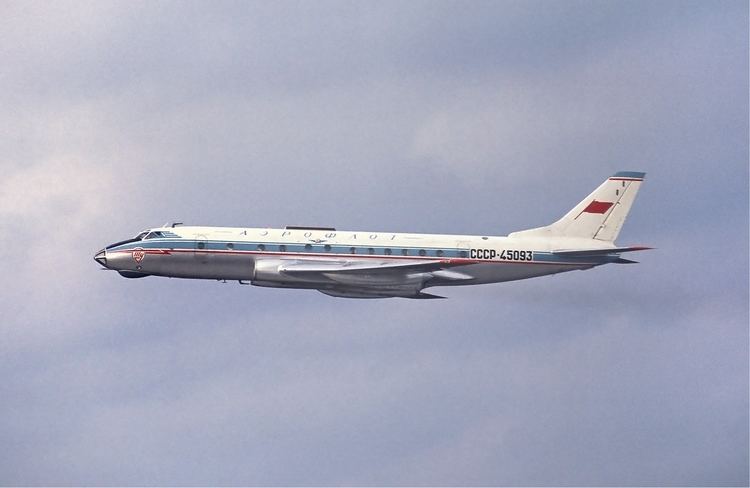 | ||
Fs2004 tupolev tu 124 engine start up and take off at stockholm arlanda
The Tupolev Tu-124 (NATO reporting name: Cookpot) was a 56-passenger short-range twinjet airliner built in the Soviet Union.
Contents
- Fs2004 tupolev tu 124 engine start up and take off at stockholm arlanda
- Design and development
- Operational history
- Competition within the COMECON
- Variants
- Civil operators
- Military operators
- Accidents and incidents
- Specifications Tu 124V
- References
Design and development
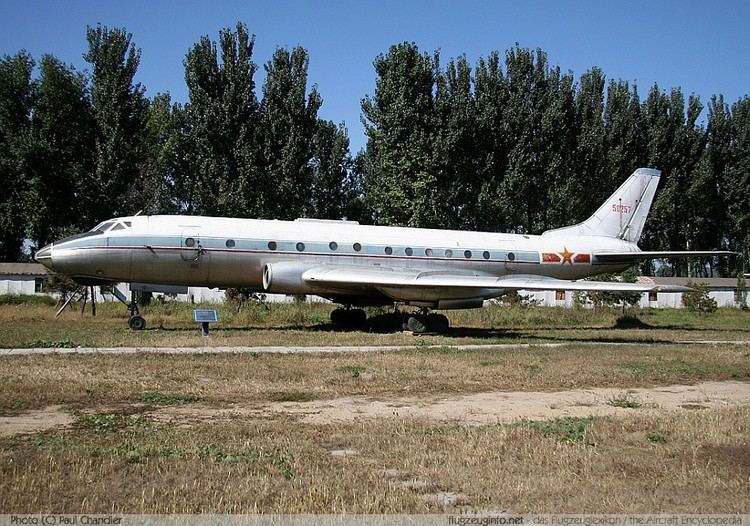
Developed from the medium-range Tupolev Tu-104, the Tu-124 was meant to meet Aeroflot's requirement for a regional airliner to replace the Ilyushin Il-14 on domestic routes. Resembling a 75% scaled-down Tu-104, the two were hard to tell apart at a distance but it was not a complete copy of the Tu-104. The Tu-124 had a number of refinements, including double-slotted flaps, a large centre-section airbrake and automatic spoilers. Unlike the Tu-104, the wing trailing edge inboard of the undercarriage was unswept.
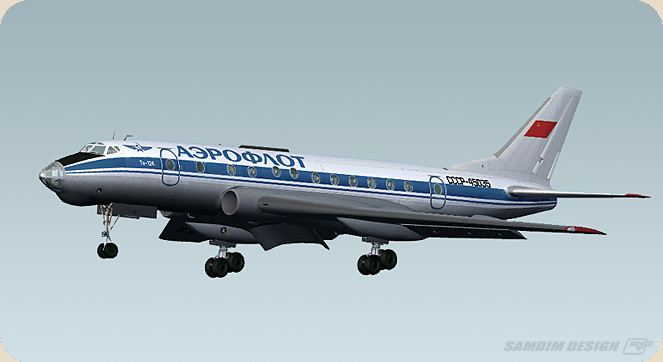
The Tu-124 retained a drogue parachute to be used in an emergency landing or landing on a slippery surface and had low pressure tires to aid operation from unpaved airfields. As on the Tu-104 the engines were integrated into the wings, but the turbofan engines were more fuel efficient. The placement of the engines amplified vibrations, which affected the comfort of the passenger cabin, and also the fatigue lifetime of the wing assembly.
The standard seating of the basic version was 44 seats. The first of two prototype, SSSR-45000 (C/N 0350101) made its first flight from Zhukovsky airfield on 24 March 1960. The second prototype, SSSR-45001 (C/N 0350102), followed in June 1960. Two other airframes served as a static test cells. Testing was successful, and the aircraft entered production at Factory 135 at Kharkov, Ukraine, replacing the Tu-104 in production. Deliveries to Aeroflot began in August 1962, with the type operating its first scheduled passenger service, between Moscow and Tallinn in Estonia, on 2 October 1962.
Operational history
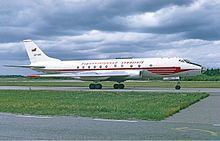
Aeroflot was impressed with the flight performance of the Tu-124 and used it on domestic routes from the end of 1962.
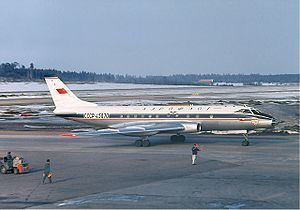
The improved Tu-124V, which could seat 56 passengers instead of the 44 of the original model, and which had increased range and maximum take-off weight, came into service in 1964. An Aeroflot Tu-124V was exhibited at the 1965 Paris Air Show. Despite the aircraft's low purchase price (stated as $1.45 million in 1965) and low operating costs, few were exported, with Československé Státní Aerolinie (ČSA) and the East German airline Interflug being the only airlines other than Aeroflot that bought the Tu-124 new, although ČSA sold its surviving Tu-124s to Iraqi Airways for use on VIP flights in 1973. Interflug used its three Tu-124s as an alternative to the Ilyushin Il-62, when the Il-62s were grounded due to mechanical issues. All three were sold back to the Soviet Union in 1975.
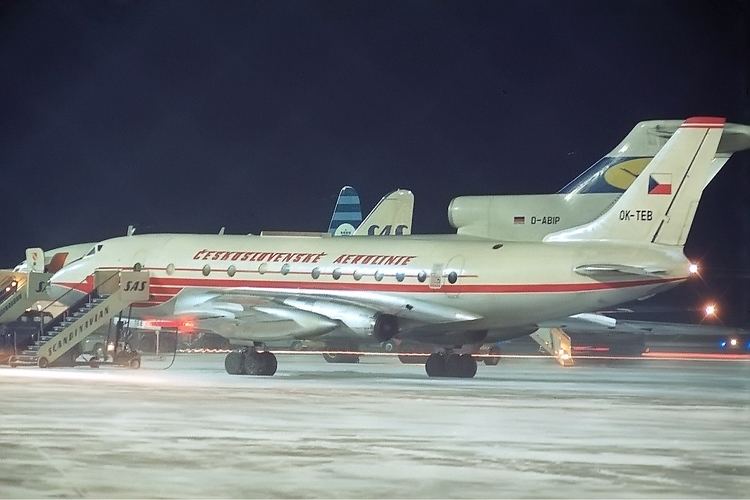
Three airframes were completed in 1966 in a VIP configuration, and designated Tu-124K. However, Aeroflot never placed them into service, and they were purchased by the Indian Air Force.
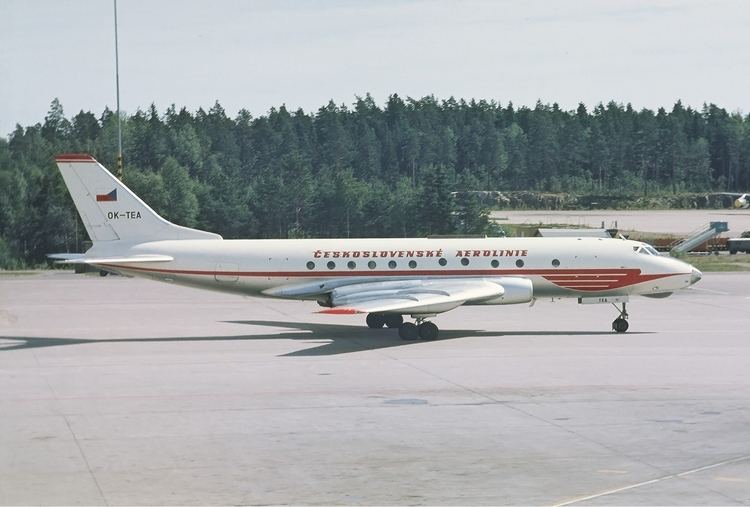
A number were also sold to military users, including the Soviet Air Force, which used them as navigational trainers, and to the Chinese Air Force.
A total of 164 Tu-124s were built. Issues with the safety of the Tu-104 affected the fate of the Tu-124, although the reliability of the Tu-124 was slightly better. Production ended in 1965 and Aeroflot decommissioned its last twelve Tu-124s on 21 January 1980. The Tu-124 continued in operation for some years with the Soviet Air Force and in Iraq, but all aircraft were withdrawn before and at 1990, The ones in Iraq military and Iraqi Airways were destroyed in early 1990s during a war.
Several Tu-124s have been preserved. One is in the museum of Kharkiv State Aircraft Manufacturing Company (formerly the Tu-124 manufacturer Factory 135), another is in China's Datangshan aviation museum in Beijing and a third is at the Central Air Force Museum at Monino outside Moscow. A Tu-124K is on display at New Delhi Airport.
Competition within the COMECON
The German Democratic Republic attempted to compete within the COMECON trading bloc with its own four-engined design called the Baade 152. The design was unsuccessful, leading Interflug to buy a rear-engined development of the Tu-124, the Tupolev Tu-134.
Variants
Civil operators
Military operators
Accidents and incidents
A total of fourteen Tu-124s were written off in crashes during the type's operational career; another two aircraft of Iraqi Airways were destroyed on the ground during the Gulf War.
Specifications (Tu-124V)
Data from Soviet Transport Aircraft since 1945
General characteristics
Performance
